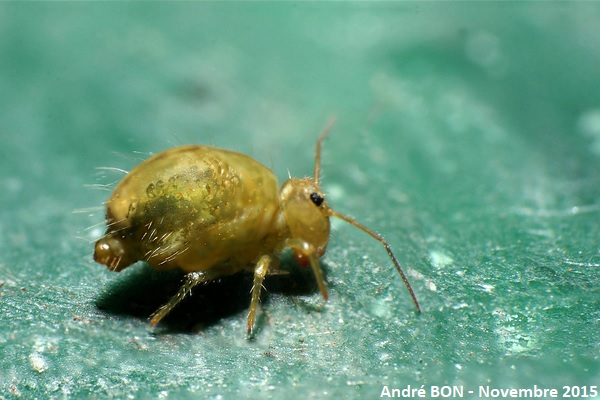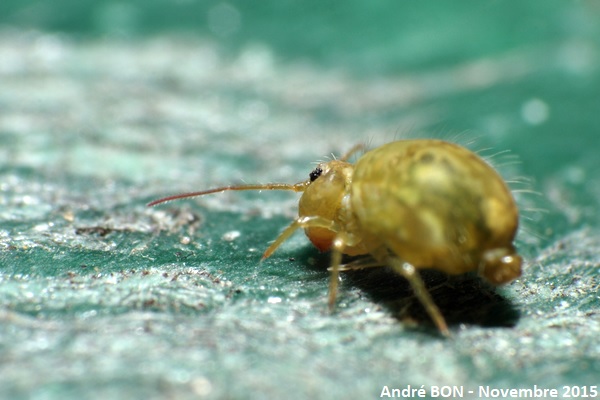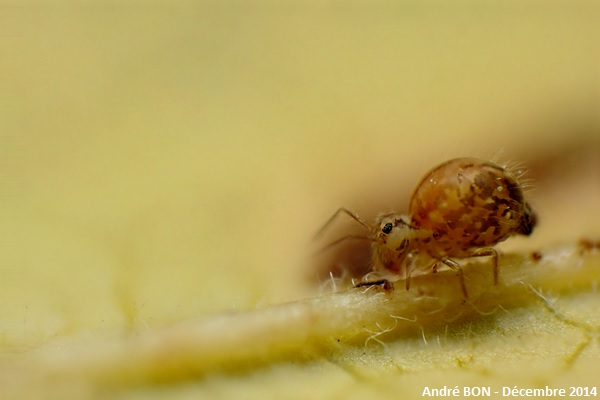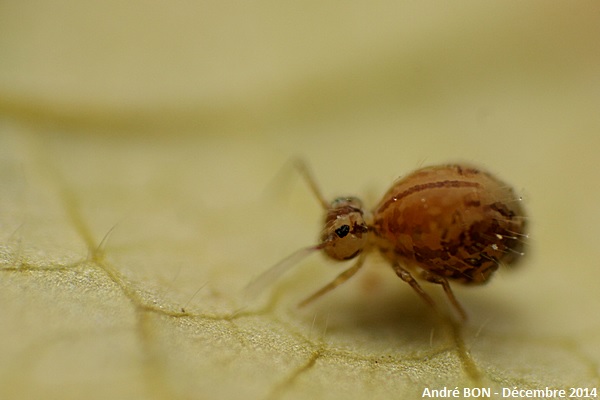




| Clover springtail (Sminthurus viridis (Linnaeus, 1758)) |





|
|
Scientific name: Sminthurus viridis (Linnaeus, 1758) Common name: Clover springtail Other names: Lucerne Flea, Lucerne Earth Flea French name: Puce de la luzerne Phylum: Arthropoda Class: Collembola Order: Symphypleona Family: Sminthuridae Size: 2-3 mm. Habitat: Among vegetation with leguminous plants including Clover and Lucerne fields. Food: Leguminous plants including Clover and Lucerne. It is considered as a pest for these crops in the areas where there is no predator. Reproduction: Males deposit spermatophores (small capsules containing spermatozoa and attached to the substrate by a small peduncle) which are then collected by the females. Geographic area: Originated from Eurasia, introduced to the Americas, to South Africa, to Australia and to New Zealand. |
Springtails of the Sminthuridae family shows a globulous body and eight ocelli on each side of the head, grouped to form a black spot. The antennae have 4 articles. The last one is very long. The antennae are often angled between the third and fourth article. They can perform spectacular jumps using their furca under the tip of their abdomen. Sminthurus viridis is variable in colour, from green to yellow with variable markings which are sometimes very dark. There are medium length bristles distributed all over the body. Thee fourth article of the antennae is divided into 18 sub-segments. The third article bears long setae at the base and shorter setae at the apex. There are many sub-species including Sminthurus viridis ssp. cinereoviridis which is yellowish in colour with a very dark dorsal line and very dark spots, Sminthurus viridis ssp. nigromaculata which is yellow in colour with pale brown spots and two dark spots on the upper side of the abdomen tip, among other sub-species. |
| [To know more about the Clover springtail] [Next picture] [Top] |

|
I think that this one is the typical form of Sminthurus viridis. This picture is a merge of 3 shots. |
| [To know more about the Clover springtail] [Next picture] [Previous picture] [Top] |

|
I tried here to get both sharp eye and sharp antenna on a single shot. The result is not perfect but this is very difficult because of the very small size of the subject. |
| [To know more about the Clover springtail] [Next picture] [Previous picture] [Top] |

|
This picture is the merge of 4 shots each with a small focus shift. The mobility of this small springtail did not allow me to have a clear picture of the antennae. However we can evaluate the length of the fourth segment which is about half the length of the antenna. You can also see the long setae at the base of the third segment. You can see the bristles of medium length on the rear part of the abdomen but the background colour does not allow them to be seen clearly on the front. The rather dark markings make me think to Sminthurus viridis ssp. cinereoviridis, but I am not totally sure. |
| [To know more about the Clover springtail] [Next picture] [Previous picture] [Top] |

|
Here is one single picture shot with my 24mm lenses mounted the reverse way and with the aperture blocked at F/10. The eye is sharp but the depth of field is very short. That's why I try to merge several shots ("focus stacking") for these tiny subjects. |
| [To know more about the Clover springtail] [Previous picture] [Top] |

|
This picture is the merge of 2 shots each with a small focus shift. I observed this springtail while I was picking up the fallen leaves under my cherry tree. Now that I know more about this species I know that I should have not searched other specimens among the litter but on the few clover plants that are growing on my lawn. |